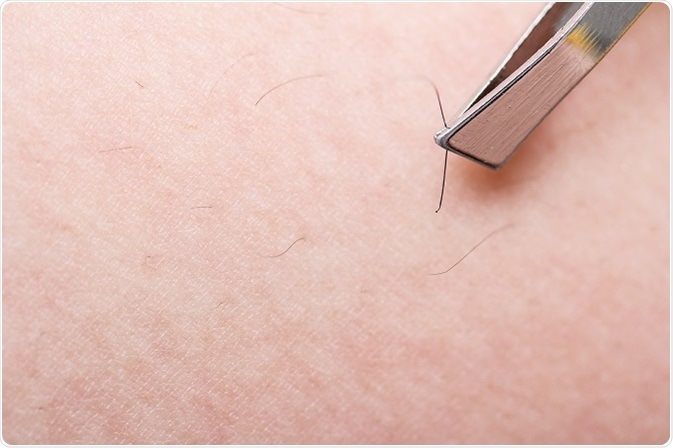By Jeyashree Sundaram, MBA
The process of cutting hair involves a lot of possibilities. Cutting hair may force the hair back to its follicle or to the adjacent follicle; also when dead skin clogs the hair follicle, the hair could grow under the skin. Instead of pushing the skin surface the hair grows inward, leading to ingrown hair.
The human body identifies ingrown hair as a foreign particle and triggers a reaction such as a red, swollen, and itchy area. The area begins to resemble a pimple that is inflamed, painful, and with pus formation.

© Shaynepplstockphoto/Shutterstock.com
Ingrown hair can be released when the beard area is cleaned in a circular motion using a soft toothbrush or a washcloth. A sterile needle can be inserted under the loop of the hair and the end of the ingrown hair can be pulled out to the surface. Consulting a physician will help when there is a lot of ingrown hair.
Exfoliation Techniques
When the hair is coarse or curly, there is greater possibility of ingrown hair. When the coarse or curly hair is cut, it may result in pseudofolliculitis—a type of ingrown hair. Medications are available for reducing inflammation, treating infection, and removing dead skin cells.
A few simple home remedies can improve the healing process and reduce redness and inflammation.
Sugar Scrubber
Sugar scrubs could help to get rid of hair follicles that are infected, by washing and removing dead cells. In this process, the ingrown hair comes out of the skin and the skin becomes smooth and silky. Sugar scrubs can be prepared by mixing a cup of white sugar, half cup of jojoba oil or extra-virgin olive oil, 10 drops of lavender essential oil, and 10 drops of tea tree oil. This mixture is to be gently rubbed on the skin in a circular motion for a couple of minutes, and then rinsed off with lukewarm water. Practicing this for a minimum of twice a week shows good results.
Baking Soda Scrubber
Make a solution with 1 cup water and 1 tablespoon of baking soda. Dipping a cotton ball in this solution and dabbing on the infected hair follicles lightly will relieve itching. Allow the mixture to stay for 5 min and then using cold water wash the area. As per requirement, this scrubbing can be done twice or thrice daily. Another variation of the baking soda scrubber is to make a paste with 1 teaspoon of baking soda and 1 teaspoon of ground oatmeal in 1 tablespoon of water.
Apply this paste on the skin gently and allow to stay for a period of not more than 5 min. Then rinse with lukewarm water and gently pat to dry; this will be soothing for the skin as the scrubber has anti-inflammatory properties. The scrubber will exfoliate the skin and lessen redness caused by ingrown hairs. This remedy can be followed twice a day.
Tea Tree Oil
Wash the affected area with antibacterial soap and apply a solution of distilled water (2 tablespoons) and tea tree oil (5 drops) on it. Allow to stay for 10 min before rinsing off with lukewarm water. Massaging the affected area with a mixture of tea tree oil (3 drops) and olive oil (1 tablespoon) gently, keeping for 10 min, and washing off with warm water also helps.
This remedy can be followed twice a day. The antiseptic, anti-inflammatory, and antibacterial properties of tea tree oil help in healing the affected hair follicle, while at the same time preventing infection.
Aspirin Paste
Aspirin has the potential to lessen inflammation and redness, which are common symptoms of ingrown hair. Aspirin possesses anti-inflammatory properties that decrease the swelling and help in treating mild infection. The presence of salicylic acid in aspirin acts like a scrubber and removes dead skin that could clog the follicle.
Using warm water of about 1 teaspoon, make a paste with 1 teaspoon of honey and 2 aspirin tablets. Apply this paste-like consistency on the affected area. Rinse it with warm water after allowing the paste to stay for about 10 min. Following this remedy once or twice a week is beneficial; however, this remedy is not advised for those with highly sensitive skin.
Salt
Mixing one and a half teaspoons of table salt in 1 cup of lukewarm water makes a salt solution ready. Scrub the affected skin area gently with a cotton ball dipped in the salt solution. Then rinse with water after leaving the solution to stay for a few minutes.
Practice this remedy twice a day till the infected hair follicle clears up. However, when individuals experience irritation or redness in the skin, then it is advised to stop using this remedy. Salt helps to remove dead cells, increases circulation, reduces swelling, and promotes healing.
Further Reading
Last Updated: Dec 28, 2022